Sometimes… There’s More Than Meets The Eye. 👀 You’re Looking At Two Very Different Takes On
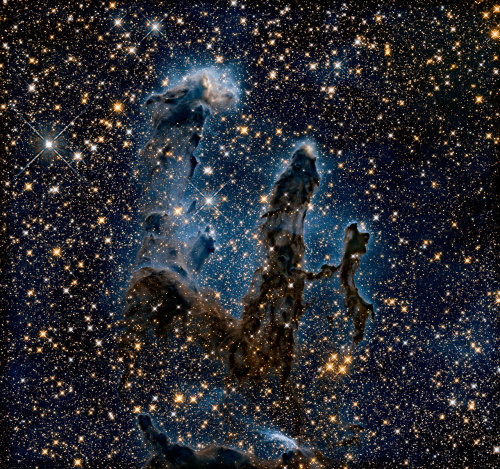
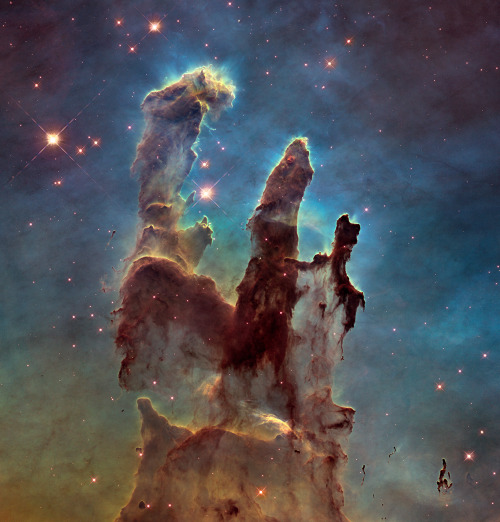
Sometimes… there’s more than meets the eye. 👀 You’re looking at two very different takes on an iconic image.
Human eyes can see only a small portion of the range of radiation given off by the objects around us. We call this wide array of radiation the electromagnetic spectrum, and the part we can see visible light.
In the first image, researchers revisited one of Hubble Space Telescope’s most popular sights: the Eagle Nebula’s Pillars of Creation. Here, the pillars are seen in infrared light, which pierces through obscuring dust and gas and unveil a more unfamiliar — but just as amazing — view of the pillars. The entire frame is peppered with bright stars and baby stars are revealed being formed within the pillars themselves. The image on the bottom is the pillars in visible light.
Image Credit: NASA, ESA/Hubble and the Hubble Heritage Team
Make sure to follow us on Tumblr for your regular dose of space: http://nasa.tumblr.com.
More Posts from Luhuhul and Others

by Burçin Esin





Amélie (2001) dir. Jean-Pierre Jeunet
Era la persona más hermosa que había visto en mi vida. Me pregunto si alguna vez alguien pensará lo mismo sobre mí.
Cartas de amor a los muertos - Ava Dellaira









Loving Vincent characters and their corresponding portraits



Details #2 : Mid Ocean and The Ocean, ca. 1900, by Frederick Judd Waugh.

Dancer in the Dark (1999) dir. Lars von Trier
“This isn’t the last song, there’s no violin, the choir is quiet, and no one takes a spin, this is the next to last song, and that’s all…”




Wildflowers in Fog, Mount Rainier by Lazgrapher
“Pero ¿cuándo el amor s propiamente amor? ¿Puede uno amar a quien le acompañó por una hora? ¿Por dos horas, dos meses, dos años, dos minutos? ¿Se ama a quien se conoce, justamente por eso, o es quizás al revés: conocemos para mejor desconocer, y así poder amar sin el estorbo de la realidad? ¿No es cierto que quienes más se aman son a veces quienes menos se conocen? Ni una sola de estas preguntas se plantea jamás para buscar respuesta verdadera. Ninguna la tiene, ni la tendrá, a menos que uno decida imponérsela, casi siempre de acuerdo con su más absoluta inconveniencia. Incluso sin respuesta, lanzadas al espacio estratosférico de los propios insomnios, las preguntas que apuntan hacia la probable existencia del amor suelen aparecer cuando no queda tiempo, ni voluntad, ni siquiera osadía para ponerlas en duda. Preguntarse si por casualidad se ama equivale a plantear una alternativa entre felicidad y desdicha, buena y mala fortuna, besos y bofetadas.”
— -Xavier Velasco, DIablo Guardián.




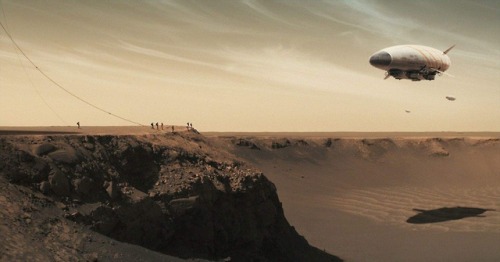
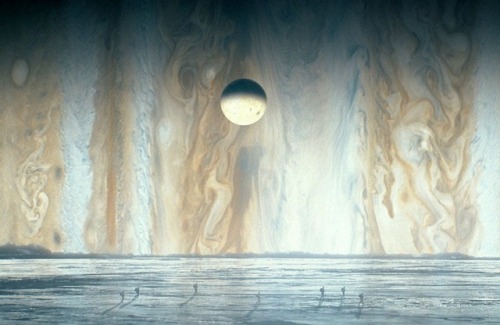

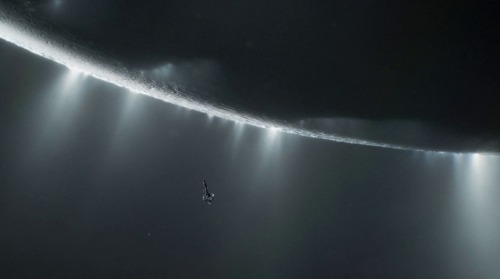
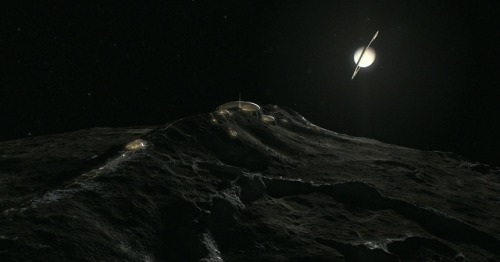
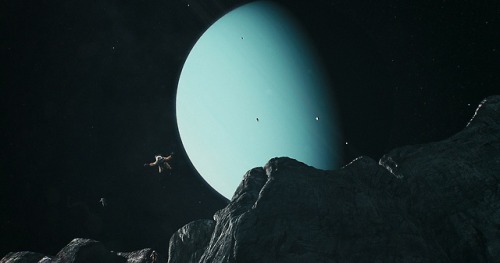
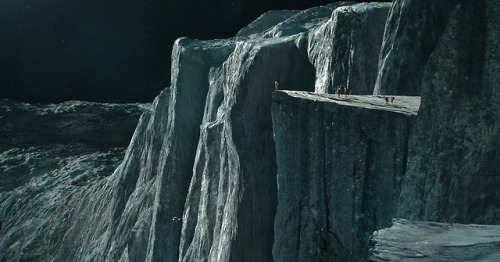

Will we one day explore the worlds of our solar system? How long will this take?
We have a diversity of worlds in our solar system. Majestic places…
Imagine being able to visit Mars and its hostile climate. Imagine being able to visit the moons of Jupiter, observe Io: the volcanic moon, Europa, the frozen moon and Ganymede a moon larger than Mercury itself and that has its own magnetic field. Imagine visiting the moons of Saturn and maybe passing close to your rings… Imagine orbiting or floating through Titan’s atmosphere and closely watching its lakes and seas of methane and liquid ethane. Imagine getting to know the geysers of Enceladus, the valleys of Tethys, and the craters of Mimas… Imagine being able to see the moons of Uranus and have a view of Verona Rupes, the largest cliff of the solar system, located in Miranda. Imagine being able to be in Triton and to be able to observe the cold and azualdo Neptune in the sky…
-
 whateverthewiz reblogged this · 2 months ago
whateverthewiz reblogged this · 2 months ago -
 whateverthewiz liked this · 2 months ago
whateverthewiz liked this · 2 months ago -
 jfictitional liked this · 2 months ago
jfictitional liked this · 2 months ago -
 nvrknowsbest liked this · 2 months ago
nvrknowsbest liked this · 2 months ago -
 carpe-kairos liked this · 2 months ago
carpe-kairos liked this · 2 months ago -
 gomodernart liked this · 2 months ago
gomodernart liked this · 2 months ago -
 powlor liked this · 2 months ago
powlor liked this · 2 months ago -
 abstractandedgyname liked this · 2 months ago
abstractandedgyname liked this · 2 months ago -
 o-blivia reblogged this · 2 months ago
o-blivia reblogged this · 2 months ago -
 thefourthman07 liked this · 2 months ago
thefourthman07 liked this · 2 months ago -
 cybermax reblogged this · 2 months ago
cybermax reblogged this · 2 months ago -
 isbbc liked this · 2 months ago
isbbc liked this · 2 months ago -
 cybermax liked this · 2 months ago
cybermax liked this · 2 months ago -
 kachowwshrek liked this · 2 months ago
kachowwshrek liked this · 2 months ago -
 icyhot65 liked this · 2 months ago
icyhot65 liked this · 2 months ago -
 wafflefriesandbowties reblogged this · 2 months ago
wafflefriesandbowties reblogged this · 2 months ago -
 wafflefriesandbowties liked this · 2 months ago
wafflefriesandbowties liked this · 2 months ago -
 adventurespnw reblogged this · 2 months ago
adventurespnw reblogged this · 2 months ago -
 adventurespnw liked this · 2 months ago
adventurespnw liked this · 2 months ago -
 mysinfulthoughts reblogged this · 2 months ago
mysinfulthoughts reblogged this · 2 months ago -
 whatareyoureallyafraidof reblogged this · 2 months ago
whatareyoureallyafraidof reblogged this · 2 months ago -
 tooshytoexist reblogged this · 4 months ago
tooshytoexist reblogged this · 4 months ago -
 thewriteitinerary reblogged this · 8 months ago
thewriteitinerary reblogged this · 8 months ago -
 jadedpeakearthghoul liked this · 1 year ago
jadedpeakearthghoul liked this · 1 year ago -
 neist reblogged this · 1 year ago
neist reblogged this · 1 year ago -
 brightmane57 reblogged this · 1 year ago
brightmane57 reblogged this · 1 year ago -
 brightmane57 liked this · 1 year ago
brightmane57 liked this · 1 year ago -
 foxysoxes liked this · 1 year ago
foxysoxes liked this · 1 year ago -
 impossiblewizardtraveler-blog reblogged this · 1 year ago
impossiblewizardtraveler-blog reblogged this · 1 year ago -
 impossiblewizardtraveler-blog liked this · 1 year ago
impossiblewizardtraveler-blog liked this · 1 year ago -
 bowlingbum liked this · 1 year ago
bowlingbum liked this · 1 year ago -
 swords0827 liked this · 1 year ago
swords0827 liked this · 1 year ago -
 stefan13exe liked this · 1 year ago
stefan13exe liked this · 1 year ago -
 clonejack liked this · 1 year ago
clonejack liked this · 1 year ago -
 1412kk reblogged this · 1 year ago
1412kk reblogged this · 1 year ago -
 1412kk liked this · 1 year ago
1412kk liked this · 1 year ago -
 whatareyoureallyafraidof reblogged this · 1 year ago
whatareyoureallyafraidof reblogged this · 1 year ago -
 kanicolle liked this · 1 year ago
kanicolle liked this · 1 year ago -
 saphicspacesociety14 reblogged this · 1 year ago
saphicspacesociety14 reblogged this · 1 year ago -
 thenecropolix reblogged this · 1 year ago
thenecropolix reblogged this · 1 year ago -
 svarte-troner liked this · 1 year ago
svarte-troner liked this · 1 year ago -
 crucrionnia reblogged this · 1 year ago
crucrionnia reblogged this · 1 year ago -
 urdagtafuly liked this · 1 year ago
urdagtafuly liked this · 1 year ago
